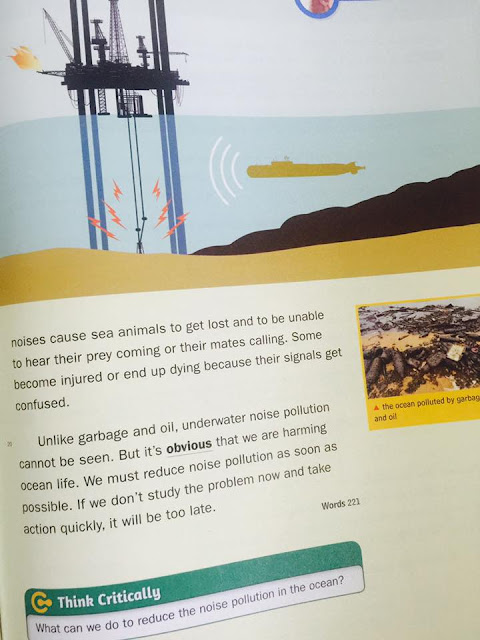Wednesday, October 19, 2016
LESSON 27: SILENT NO MORE
COMPREHENSION:
1. What is the main idea of the passage?
2. What do sea animals use sound for?
3. What are some other things that pollute the ocean?
4. Why do some people drill deep into the sea floor?
5. What can we do to stop noise pollution in the ocean?
GRADE;
Tuesday, October 18, 2016
LESSON 26: HOW WE HEAR SOUNDS?
COMPREHENSION:
1. What is the passage about?
2. What cause tiny hars inside the ear to vibrate/
3. How adoes the brain know that there is sound?
4. Why is space a silent space?
5. How do you hear?
GRADE:
Monday, October 17, 2016
LESSON 25: SALAMI AND KIMCHI
COMPREHENSION;
1. What is the passage about?
2. How does salt preserve food?
3. What does "Salami" mean?
4. What do you need to make a kimchi?
5. What do you need to make salami?
6. Why salt is important in preserving food?
GRADE: A+
LESSON 25: SALAMI AND KIMCHI
COMPREHENSION;
1. What is the passage about?
2. How does salt preserve food?
3. What does "Salami" mean?
4. What do you need to make a kimchi?
5. What do you need to make salami?
6. Why salt is important in preserving food?
GRADE:
Friday, October 14, 2016
LESSON 24; SALAR DE UYUNI
COMPREHENSION:
1. What is the passage about?
2. What makes Salar de Uyuni look like a mirror?
3. Where is Salar de Uyuni?
4. Why do people visit Salar de Uyuni?
5. Why do the fun photos taken at Salar de Uyuni look real?
GRADE:
Thursday, October 13, 2016
LESSON 23: OUR BODIES AND SALT
COMPREHENSION:
1. What is the passage about?
2. Which part of the body can be harm by too much salt?
3. How does salt improve food?
4. Why do the nerves and brain need salt?
5. Do you think you consume too much salt?
6. Can you give up eating salty food?
GRADE:
LESSON 22: HISTORY OF SALT
COMPREHENSION:
1. What is the passage about?
2. What can you say about using the salt long time ago?
3. Do you think salt is important? Why?
4. Why salt is valuable before?
5. Why do they use salt to pay for something?
Grade: A+
Tuesday, October 11, 2016
LESSON 21; DYEING NATURALLY
COMPREHENSION
1. What is the passage about?
2. What were unriPe persimmons used for before garot?
3. What are the step in persimmon dyeing?
4. Before people developed chemical dyes, what did they use?
5. What is the negative thing about natural dyeing , compared to the chemical dyeing?
GRADE: A+
Monday, October 10, 2016
LESSON 20: CHINESE BELIEFS ABOUT COLORS
COMPREHENSION:
1. What is the passage all about?
2. Which color did the Chinese usually wear when their love ones died?
3. What did the color yellow mean to Chinese?
4. What gifts did the Chinese usually give at celebration?
5. What did the color green represent to the people?
6. Which color has a special meaning to your culture?
GRADE: A+
Friday, October 7, 2016
LESSON 18: HEALING WITH COLORS
HEALING WITH COLORS
Nowadays, natural healing methods are becoming more popular. Color therapy is one of the oldest natural therapies. It has been used since ancient times. According to color therapists, colors can affect us both mentally and physically. That's because color is light of a certain wavelength and energy, so each has unique healing powers.
Warm colors, such as red, orange, and yellow, are thought to have energizing effects. Color therapists believe red can help increase blood flow, reduce tiredness, and relieve colds.They think yellow helps you feel better when you feel down. They also think it helps when you have trouble digesting food.
On the other hand,cool colors, such as violet, blue, and green , are thought to have calming effects. They are thought to make you relaxed. You can use blue and violet to relieve headaches and heal wounds. They can also help you get a good night's sleep.
Try color therapy in your daily life. You can decorate your room with a certain color, wear clothes that have your favorite color, or eat some colored food. Or, you can simply imagine that color. But don't focus on one color all the time. It might have a bad effect on you. Just try different colors to see how you feel about them.
What color would help you feel better now? Why?
GRADE A+
Thursday, October 6, 2016
Wednesday, October 5, 2016
LESSON 16: THE MYSTERIOUS PAINTINGS OF SALVADOR DALI
COMPREHENSION:
1. What is the main idea of this passage?
a. Dali was a very strange and mysterious person.
b. Dali’s melting clocks are famous now.
c. Dali’s paintings are full of mysterious objects.
2. Which is NOT true about Dali’s paintings?
a. The objects in them are usually very strange.
b. They are easy to understand.
c. The objects in them are often from his dreams.
3. What is strange about the clocks in The Persistence of Memory?
a. They show the wrong time.
b. They look like Dali.
c. They are melting.
4. Which is NOT in The Persistence of Memory?
a. a dead-looking tree on a table
b. an upside-down clock
c. a dolphin in a river
5. There are many on the upside-down clock in the picture.
a. trees
b. ants
c. bees
READ AGAIN:
GRADE:
Tuesday, October 4, 2016
Thursday, September 29, 2016
LESSON 15: A WORKOUT FOR EYES
1. What is this passage mainly about?
a. the importance of eye exercises
b. three exercises to keep your eyes healthy
c. the best way to read calendars
2. What do you need to practice focusing?
a. a clock and a pencil
b. a calendar and a pencil
c. a clock and a letter
3. When you practice focusing, how far do you stand away from the calendar?
a. thirty centimeters
b. two meters
c. three meters
4. Pretending to with your eyes can be a good exercise.
a. write the alphabet
b. see a clock
c. move your head
5. Which is NOT true about the eye exercises?
a. When you roll your eyeballs, roll them clockwise five times.
b. When you write with your eyes, you can move your head.
c. When you write with your eyes, you should write as big as you can.
READ AGAIN
GRADE:
LESSON 14; MORRIS FRANK AND HIS SEEING EYE DIG, BUDDY
COMPREHENSION:
1. What is this passage mainly about?
a. different kinds of Seeing Eye dogs
b. how to train a Seeing Eye dog
c. the first Seeing Eye dog in North America
2. How old was Morris Frank when he became blind?
a. six
b. sixteen
c. nineteen
3. What was Dorothy Harrison Eustis’s newspaper article about?
a. a school called The Seeing Eye
b. breeding dogs in Tennessee
c. training dogs to help blind people
4. Blind people can have more with Seeing Eye dogs.
a. freedom
b. problems
c. friends
5. What did Eustis do in the United States?
a. She walked across streets with Buddy.
b. She started a school to train dogs.
c. She taught blind people in schools.
READ AGAIN
GRADE;A+
LESSON 13: OUR AMAZING ALASKA VACATION!
COMPREHENSION:
1. What is this passage mainly about?
a. taking photographs of glaciers
b. visiting glaciers in Alaska
c. hiking on glaciers in Alaska
2. Glaciers are pieces of ice that slowly across the land.
a. tiny, move
b. big, fall
c. massive, move
3. How many glaciers does Alaska have?
a. nearly 10,000
b. nearly 100,000
c. nearly 1,000,000
4. What does the word It in the third paragraph refer to?
a. a splash
b. a cruise ship
c. a cave
5. Which is true about the Hubbard Glacier?
a. It is the longest glacier in the world.
b. It is a valley glacier.
c. Steve saw it from a cruise ship.
READ AGAIN
GRADE; A+
Tuesday, September 27, 2016
LEESON 12; JEAN DE MAIRAN'S AMAZING DISCOVERY
COMPREHENSION:
1. What is the main idea of this passage?
a. Jean de Mairan taught other astronomers about plants.
b. Jean de Mairan grew a mimosa plant in his cupboard.
c. Jean de Mairan discovered an amazing fact about plants.
2. Which is NOT true about de Mairan?
a. He was a French astronomer.
b. He invented a special clock.
c. He tried an experiment on a mimosa plant.
3. Before the experiment, what did de Mairan think would happen?
a. The mimosa plant would die without the sun.
b. The mimosa plant’s leaves would grow longer without the sun.
c. The mimosa plant’s leaves wouldn’t open or close without the sun.
4. What does the word it in the third paragraph refer to?
a. de Marian
b. the mimosa plant
c. the cupboard
5. Even without the sun, the plant knew .
a. when it was day and night
b. who put it in the cupboard
c. how to keep growing
READ AGAIN
GRADE: A+
LESSON 11: TELLING TIME
COMPREHENSION:
1. What is the main idea of this passage?
a. Ancient people in West Asia could not tell time at night.
b. Ancient people used sundials and water clocks to tell time.
c. Ancient buildings were often used to tell time.
2. What did sundials use to tell the time?
a. the wind
b. the moon
c. shadows
3. What does the word They in the second paragraph refer to?
a. people in West Asia
b. smaller sundials
c. tall poles
4. How did people tell time using water clocks?
a. The marks on the water container showed the time.
b. The water in the second container showed the time.
c. The position of the sun and its shadow told the time.
5. The water in the second container was used to
.
a. drink
b. wash the first container
c. refill the clock
READ AGAIN
GRADE: A+
Monday, September 26, 2016
LESSON 10: WHERE DID OUR CALENDAR COME FROM?
COMPREHENSION
1. What is this passage mainly about?
a. the history of calendars
b. the history of Babylon
c. Julius Caesar and his calendar
2. Which is NOT true about the Babylonian calendar?
a. It had 12 lunar months.
b. It was based on the sun’s cycles.
c. It had 354 days each year.
3. What did the ancient Egyptians look at to make their calendar?
a. the sun and the moon
b. the moon and the Dog Star
c. the sun and the Dog Star
4. A year with an extra day is called .
a. a Gregorian year
b. a leap year
c. a lunar year
5. Which calendar do we use today?
a. the Roman calendar
b. the lunar calendar
c. the Gregorian calendar
READ AGAIN
GRADE:A+
Subscribe to:
Comments (Atom)















































